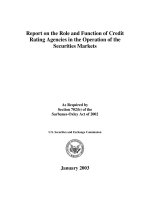The Simple Dollar Elements of Investing_8 potx
Bạn đang xem bản rút gọn của tài liệu. Xem và tải ngay bản đầy đủ của tài liệu tại đây (458.1 KB, 17 trang )
139
RECOMMENDED
READING
If you’d like to learn more about investing, these are the
books we recommend:
John C. Bogle, Common Sense on Mutual Funds: New
Imperatives for the Intelligent Investor (John Wiley &
Sons, 2000).
John C. Bogle, The Little Book of Common Sense Investing:
The Only Way to Guarantee Your Fair Share of Stock
Market Returns (John Wiley & Sons, 2007).
Jonathan Clements, 25 Myths You’ve Got to Avoid—If You
Want to Manage Your Money Right: The New Rules for
Financial Success (Fireside, 1999).
both2.indd 139both2.indd 139 10/31/09 1:34:06 PM10/31/09 1:34:06 PM
140
Recommended Reading
Charles D. Ellis, Winning the Loser ’ s Game; Timeless
Strategies for Successful Investing , fi fth edition (McGraw -
Hill, 2009).
Benjamin Graham, The Intelligent Investor: The Defi nitive
Book on Value Investing. A Book of Practical Counsel,
with commentary by Jason Zweig (Collins Business,
2003).
Burton G. Malkiel, A Random Walk Down Wall Street:
The Time - Tested Strategy for Successful Investing, revised
and updated edition (W.W. Norton & Co., 2007).
David F. Swensen, Unconventional Success: A Fundamental
Approach to Personal Investment (The Free Press,
2005).
David F. Swensen, Pioneering Portfolio Management: An
Unconventional Approach to Institutional Investment,
fully revised and updated (The Free Press, 2009).
Andrew Tobias, The Only Investment Guide You ’ ll Ever
Need (Harvest Books, 2005).
Jason Zweig, Your Money and Your Brain: How the New
Science of Neuroeconomics Can Help Make You Rich
(Simon & Schuster, 2008).
both2.indd 140both2.indd 140 10/31/09 1:34:06 PM10/31/09 1:34:06 PM
141
ACKNOWLEDGMENTS
William S. Rukeyser, editor extraordinaire, used his
deft skills to clarify and simplify every page. On behalf of
all readers, thank you, Bill.
We also salute our wonderful wives, Nancy Weiss
Malkiel and Linda Koch Lorimer. Vanessa Mobley,
Meg Freeborn, and Bill Falloon provided perceptive
questions and many helpful suggestions. Ellen DiPippo,
Catharine Fortin, and Kimberly Breed made vital con-
tributions by turning our illegible scribbles into read-
able copy.
Thanks to the Center for Economic Policy Studies for
fi nancial support.
back.indd 141back.indd 141 10/31/09 1:32:28 PM10/31/09 1:32:28 PM
142
Acknowledgments
Finally, many, many thanks to our students, teach-
ers, and friends in the investment profession who, lucky
us, have included Peter Bernstein, Jack Bogle, Warren
Buffett, David Dodd, Ben Graham, Tad Jeffrey, Marty
Leibowitz, Jay Light, Charlie Munger, Roger Murray,
John Neff, Paul Samuelson, Gus Sauter, Bill Sharpe, and
David Swensen.
back.indd 142back.indd 142 10/31/09 1:32:28 PM10/31/09 1:32:28 PM
143
ABOUT THE AUTHORS
BURTON G. MALKIEL
Burton G. Malkiel is the Chemical Bank Chairman ’ s
Professor of Economics at Princeton University and the
author of the bestselling, A Random Walk Down Wall
Street. Malkiel has served as a member of the President ’ s
Council of Economic Advisers, Dean of the Yale School
of Management, Chair of Princeton ’ s Economics Depart-
ment, and as a director of major corporations.
CHARLES D. ELLIS
Charles D. Ellis is a consultant to large public and private
institutional investors. He was for three decades manag-
ing partner of Greenwich Associates, the international
babout.indd 143babout.indd 143 10/31/09 1:32:09 PM10/31/09 1:32:09 PM
144
business strategy consulting fi rm. He serves as Chair of
Whitehead Institute and as a director of Vanguard and
the Robert Wood Johnson Foundation. He has taught
investing at both Harvard and Yale and is the author of
15 books, including the bestselling Winning the Loser ’ s
Game.
About the Authors
babout.indd 144babout.indd 144 10/31/09 1:32:09 PM10/31/09 1:32:09 PM
145
INDEX
A
Accumulated savings, absence, 25–26
Actively managed bond funds,
performance, 43
Actively managed mutual funds
annual returns, S&P 500 annual
returns (comparison), 36
performance, S&P 500 index
performance (contrast), 35
Active managers, performance, 35
Adams, Scott, 6
Affl uence, examination, 3–4
After-tax returns, measurement, 88
AIG, bankruptcy, 54
Allocation ranges, 108–109
Annuities
advantage, 113
fi xed-income investments,
113–114
Anxiety reduction, diversity
(impact), 100
Asset allocation, 105–107
ranges, 107–112
example, 108–109
selection, 112
Asset classes
diversifi cation, 55–58
price, decrease, 67–68
risk reduction, 57
Asset types, diversifi cation, 126
Astrologists, impact, 78
Auto insurance
deductibles, 21
shopping technique, 19
B
Baruch, Bernard, 34
Berkshire Hathaway, 42, 49–50
fi nancial meltdown avoidance, 75
portfolio, performance, 75
Bid prices/asked prices, spreads, 37–38, 44
Bogle, John C., 139
Bond index funds
data, 120
investment percentage, 49
usage, 43
Bonds
addition, 108
focus, 103
funds, performance, 30–31
bindex.indd 145bindex.indd 145 11/2/09 2:07:25 PM11/2/09 2:07:25 PM
146
Index
Bonds (continued )
issuers, fi nancial defi ciency, 43
markets, movements, 66
overweighting, 105–106
price, increase, 70
purchase/hold, 30
U.S. Treasury issuance, 56–57
Book purchases, advice, 19
Borrowing limit, 24
Broad-based index funds
investment, 34
selection, 115
Broad-based U.S. total stock market
index fund, usage, 68
Broad diversifi cation, advantage, 100
Brokerage commissions
charges, 122
costs, 37–38
Brokers, investment, 90
Buffett, Warren, 15, 48
investment rationale, 62, 64
record, 41–42
results, 73–74
return rate, earning, 42
stock commitment, 49–50
success, reasons, 74
Bull markets, risks, 79–80
Buy-and-hold investor, portfolio
holding, 77
C
Capital
availability, 112
loss, risk, 105–106
starting level, 3
Capital gains
generation, absence, 45
index fund generation, 44–45
Cash distributions, reinvestment, 55
Cash fl ow, 83
Cash positions, market bottoms,
33–34
Cash reserve
holding, 96–98
investment, 97
overweighting, 106
Certifi cates of deposit (CDs), FDIC
insurance, 97
Christmas cards, purchase timing, 18
Chrysler, 54
bankruptcy, 53
Clements, Jonathan, 139
Coca-Cola, investment, 116
Coffee purchases, advice, 19
Coin toss, bet, 77
Commissions
income, 114
payment, 90
Commodities, diversifi er, 58
Common Sense on Mutual Funds
(Bogle), 139
Common stocks
dividends/earnings, fl uctuation, 56–57
focus, 103
holding, 100
investment risk, elimination, 64–65
portfolio, purchase, 55
Company-sponsored retirement plans,
usage, 125
Company stocks, variety (holding),
55–56
Compounding
benefi t, 10–11
example, 11–12
power, reasons, 8
Compound interest, power, 7–8
Consumption expenditures, excess, 23
Corporate-bond indexes, performance, 43
Corporation bonds, 56
Cost minimization, 87–91
Credit card charges, examination, 16–17
Credit card debt
avoidance, 6, 24, 100–101
impact, 6–7
bindex.indd 146bindex.indd 146 11/2/09 2:07:26 PM11/2/09 2:07:26 PM
147
Index
interest, 13
investment, contrast, 13
seductiveness, 7
Credit cards, convenience, 7
D
David Copperfi eld (Dickens), 4
Debt
doubling, 13
reduction, 25–27
Demographic groups, catering, 56
Derivatives, Buffett avoidance, 74–75
Dimensional Fund Advisors, 34
Dinner, spending advice, 19
Disability insurance, cost driver, 98, 100
Disempowerment, 32
Dissaving, cessation, 6–7
Diversifi cation, 51
achievement, 59–60
advantage, 100
benefi ts, 58–59
global approach, 116
mandate, 55
meaning, 54–55
timing, 60–65
Dividends, fl uctuation, 56–57
Dollar cost averaging, 61–64
bargain, 65
comparison, 63
example, 62–64
investment advisor, impact, 65
Domestic equity investments, 116, 121
Double positive shopping, practice, 16
Dow-Wilshire 5000 index, 48
Duke of Tuscany, salt tax, 22
E
Earning, spending (contrast), 6
Earnings, fl uctuation, 56–57
Education, tax-advantaged saving,
135–137
Einstein, Albert, 7–8, 93
Emerging markets
effi ciency, 44
growth, 59–60
Employer 401(k)/403(b) retirement
security plan
advantage, 95–96
contribution, 26, 134
Enron Corporation, 54
401(k) retirement plan,
establishment, 52
problems, 51–52
stock price, collapse, 52–53
Equity, 109
allocation, 111–112
investments, selection, 111
Equity funds
cash fl ow, 83
costs/net returns, 89
performance, 30–31
Equity index funds
concentration, 114
preference, 115
Equity mutual funds
examination, 88
investment, 82
performance, 40–41
Estate-tax credits, 135–136
Euphoria, contagiousness, 80
Euro, price increase, 59
Exchange-traded funds (ETFs), data,
122–123
Exchange-traded index funds (ETFs),
46–47, 121
dividends, reinvestment, 47
Exotic investments avoidance,
103–105
Expenditures
examination, 16–17
recordkeeping, 19
triage, 17
Expense ratios, 122
levels, 47, 136
bindex.indd 147bindex.indd 147 11/2/09 2:07:26 PM11/2/09 2:07:26 PM
148
Index
Expenses
reduction, 3–4
return, relationship, 96–97
F
Federal Deposit Insurance Corporation
(FDIC), savings deposits/CD
protection, 97
Federal National Mortgage Association
(FNMA), 56
Federal taxation, exemption, 98
Federal taxes, deduction, 127
Financial complexity, 93–94
Financial life, organization, 23
Financial markets, performance, 31
Financial meltdown,
avoidance, 75
Financial products, 100
Financial security, achievement, 94
Financial situation, 105
Financial weapons of mass destruction
(Buffett), 75
529 College Savings
Accounts, 135
Fixed-income investments, 113
Forecast failure, 39
401(k) investments,
application, 84
401(k) plans, 132
acceptance, 110
annual contribution, 111
contribution maximum, 134
employee contributions, 54
periodic payments, 47
403(b) retirement plans, 132
Franklin, Benjamin, 11
advice, 21–22
Future earnings, present
value, 109
Future opportunities,
advantage, 6
Future returns, predictor, 88
G
General Electric, investment, 116
General equity funds, costs/net
returns, 89
General Motors, 54
bankruptcy, 53
Gin rummy behavior, engagement,
90–91
Global diversifi cation, 116
Goals, achievement (benefi ts), 15
Gold, asset selection, 58
Government-bond indexes,
performance, 43
Government bonds, 56
Government funds, 97
Government-guaranteed bank deposits,
investment, 97
Government-sponsored enterprises
(GSEs), 56
Government-sponsored retirement plans,
usage, 125
Graham, Benjamin, 80–81, 140
Growth funds, price declines, 85
H
Hamlet (Shakespeare), 24
Hedge funds, avoidance, 103–105
Hedging, preference, 47
Herd, following, 101
High-cost funds, performance
(problem), 39
High-quality bonds, risk moderation, 57
High-tech funds
investment, 82
performance, 74
High-tech stocks, overvaluation, 102
High-yield bonds, indexes, 114
Home
mortgage, interest rate, 25
ownership, 107–108
self-ownership, 24–25
Housing prices, increase, 33
bindex.indd 148bindex.indd 148 11/2/09 2:07:26 PM11/2/09 2:07:26 PM
149
Index
I
Impulse purchases, avoidance, 16
Indebtedness, level, 23
Index funds
advantages, 44–46
basis, 121
bond, 43
cost/tax effi ciency, 45–46
investment, 42, 47
management fees, charges, 46
solution, 34–38
usage, 103
usefulness, 30
warning, 46–49
Indexing
assumption, 109
investment strategy, 30–31
performance, 44
superiority, 35
Individual Retirement Accounts (IRAs),
122, 128–129
initiation, 134
investment account, investment
earnings (tax deferral), 128
periodic payments, 47
savings program, 129
selection, 131
variation (Roth IRA), 129–132
Individual retirement plans,
contributions, 26
Infl ation
adjustment, 113–114
protection, providing, 112
Information, usage, 31–32
Institutional investors, market
domination, 102
Insurance
coverage, 98, 100
KISS principle, 98
Insurance company payments,
cessation, 113
Intelligent Investor, The (Graham), 140
Interest rates
Federal Reserve reduction, 70
forecast, 79
Intermediate maturities, 43
International equity investments,
116, 121
International indexes, 44
International stock market index funds,
data, 118
Internet banks, rates, 97
Internet crash, market
overvaluation, 102
Internet funds, investment, 82
Internet stocks
overvaluation, 102
price, increase, 33, 77
Investments
abstinence, 104
categories, focus, 103–105
complexity, 93–94
contributions, 83
earnings, tax deferral, 128
funds, diversifi cation, 55
investor perspective, 76–77
low-fee manager concentration, 20
mistakes, 75, 85–86
pattern, 86
performance, 40–41
portfolio
MBS/derivatives, impact, 74–75
risk reduction, rebalancing
(impact), 66
program, example, 62–64
proportion, increase, 67
rationale, 62, 64
returns, increase, 87–88
success, secret, 75, 106–107
timing, 13
Investors
allocation, 68
distress, 87
return (increase), rebalancing (usage), 68
bindex.indd 149bindex.indd 149 11/2/09 2:07:26 PM11/2/09 2:07:26 PM
150
Index
K
Keillor, Garrison, 37
Keogh plans, setup, 133
KISS investment, 125
KISS portfolio, 94
rules, review, 95–105
L
Large capitalization stocks, 114
Lay, Kenneth, 51–52
Lehman Brothers, bankruptcy, 54
Life, organization, 3
Life insurance, purchase, 20
Life savings, loss (example), 52–53
Liquidity, assurance, 96
Little Book of Common Sense Investing,
The (Bogle), 139
Long-term growth, attention, 106
Long-term investment
goals, achievement, 77
placement, 111
Long-term investor, 67–68
Long-term mortgage rates, level, 27
Long-term risk, 100
Lost income, coverage, 98, 100
Low-cost equity index mutual funds
purchase, 55
usage, 47
Low-cost indexed mutual funds,
Low-cost index funds
buy-and-hold investor holding, 77
charges, 37–38
investment, 30
long-term investments, 111
usage, 101–103
Low-cost money-market funds,
selection, 99
Low-cost total market index
funds, 126
Lowest-cost quartile funds, returns, 88
Low-expense plan, location, 136
Low-fee managers, usage, 10
M
Managed funds, 33–34
Management fees, charges, 46
Manufacturing, ownership interests, 103
Market
diversifi cation, 58–60
fl uctuations, 126
forecasts, 77–78
impact, costs, 37–38
meltdowns (2008-2009), 59
recovery, 82
risks
acceptance, 110
age-related tolerance, 108
second-guessing, cost, 84
trough, 82
volatility, 68
example, 62
Money
doubling, formula, 9
increase, 11
providing, saving (impact), 16
time, relationship, 7–8
withdrawal, penalty, 135
Money-market funds, safety, 97
Moonlighting income, usage, 133
Morgan, J. P., 77
Morgan Stanley Capital International
Europe, Australasia, and Far East
(MSCI EAFE), 44
Morningstar, 39
Mortgage
debt, 24–25
payment, 27
Mortgage-backed securities, Buffett
avoidance, 74–75
Mr. Market
expense, 81–82
impact, 85
objectives, 81
perspective, 79–84
short-term impact, avoidance, 101
bindex.indd 150bindex.indd 150 11/2/09 2:07:26 PM11/2/09 2:07:26 PM
151
Index
Mr. Value, perspective, 80–81
Mutual funds
investment, 35
managers, performance, 34–35
performance, 40
redemption/liquidation, 82
sale/purchase, 81
specialization, 55
top quartile performance,
ownership, 88
N
Neighbors, infl uence (test), 17
Netfl ix, usage, 19
No-load indexed mutual funds, purchase
fees (absence), 122
Non-U.S. total stock market fund, world
economy exposure, 59–60
O
Objectives, achievement, 30
Only Investment Guide You’ll Ever Need,
The (Tobias), 140
Opportunity cost, 21
Overconfi dence, 76–79
Ownership interests, 103
P
Past performance, future return
predictor, 88
Pension plans, 132–135
Performance, competition, 38–39
Pioneering Portfolio Management
(Swensen), 140
Pocket change, usage, 19
Portfolio
balance, 66
cash reserves, overweighting, 106
equity portion, 67
holding
diversifi cation, 54–55
purchase/sale cost, 88
investment, proportion, 66–67
management, charges, 37–38
market value, swing, 109–110
mix, corrective changes, 67
rebalancing, 64–66, 111–112
stock loss, 86
tax-sheltered component, 112
Preferences, expense, 18
Pre-owned cars, purchase, 20
Principal, safety, 96
Priorities, keeping, 5–6
Private equity, avoidance, 103–105
Property taxes, levy, 22–23
Public rating sources, 39
Purchase fees, absence, 122
Q
QQQQs (cubes), 121
R
Random guesses, 78–79
Random walk, 86
Random Walk Down Wall Street, A
(Malkiel), 140
Reading, recommendation, 139
Real assets, infl ation hedges, 58
Real economy developments, forecasts,
77–78
Real estate
diversifi er, 58
focus, 103
infl ation hedges, 58
Rebalancing, 65–71
annual timing, 126
importance, 69
Recession (2009), 57, 59
Retirement
account, initiation (example), 11–12
date, movement, 26–27
investments, 112–114
earnings, tax-free growth, 23
plan, periodic payments, 47
bindex.indd 151bindex.indd 151 11/2/09 2:07:26 PM11/2/09 2:07:26 PM
152
Index
Retirement (continued )
savings
approach, 132
disappearance, example, 53
steps, 125–126
Return
expenses, relationship, 96–97
increase, rebalancing
(impact), 70
Rhodes, James (savings investment
example), 53
Risk
elimination, absence, 61
incurring, 75
reduction, 60
asset classes, impact, 57
self-insuring, 21
Roth IRAs, 129–132
Roth analyzers, 131
Roth and Roll technique, 131
tax deduction, absence, 130
Rule of 72, 9–13, 22–23
application, wisdom, 13
Russell 3000 index, 48
S
Salt tax, 22
Santa Claus rally, 86
Save More Tomorrow plan,
enrollment, 21
Saving
advice, 18–20
deposit, FDIC insurance, 97
earliness/regularity, 7–8, 95
employer/government, impact,
95–96
government assistance, 22–23
inadequacy, 23
initiation, 1
intelligence, 14–18
investment, example, 53
pleasure, 14–15
process, 5
enjoyment, 15
purpose, 5–6
rationality, 15–16
reduction, 112–113
results, 5
supercharging, 95–96, 125
usefulness, 5
example, 4
weight control, comparison, 14
Savings-retirement plan, stocks/bonds
(addition), 108
Seasonal patterns, 86
Securities diversifi cation, 126
Securities markets, transformation, 102
Selection penalty, 85
Self-directed, term (meaning), 133
Self-directed retirement plans, 133
Self-employed people, income
contribution, 133
Service-oriented companies, ownership
interests, 103
Shaw, George Bernard, 10
Short-term capital gains, taxation,
44–45
Short-term maturities, 43
Short-term risk, 100
Short-term staying power, 109
Sinclair, Upton, 31
Single-family home, money investment,
107–108
Sinquefi eld, Rex, 34
60-40 balance, restoration, 111–112
Skilling, Jeff, 51–52
Slugging percentage, 39
Social Security benefi ts, increase, 27
Spending
earning, contrast, 6
increase, 17
reduction, 21
Spreads, 37–38
Spyders, 121
bindex.indd 152bindex.indd 152 11/2/09 2:07:26 PM11/2/09 2:07:26 PM
153
Index
Standard and Poor’s 500 (S&P500)
stock index, 34–35, 48,
114–116
annual returns, actively managed mutual
funds annual returns (contrast), 36
performance
equity mutual funds, comparison,
40–41
mutual funds, performance
(contrast), 35
tracking, 48
Stockbrokers, avoidance, 89–90
Stock market
beating, 38–42, 48–49
downturn, 105–106
forecast, 79
investor avoidance, 77
funds, performance, 34
increase, 61
index fund, investment, 61
investors, investment approach, 116
knowledge, 31
movements, 66
negative return, 60
performance, 31, 33, 34
pricing, correctness, 33
return
earning, 36–37
investor return, comparison, 36
Stock portfolio, global approach,
115–116
Stock prices
changes, 86
decrease, 70
news, impact, 32
Stocks
addition, 108
index funds, investment
percentage, 49
purchase/hold, 30
sale/purchase, 81
Swensen, David F., 42, 140
T
Takeover offers, 32
Taxable income
creation, 44–45
deduction, 128
generation, absence, 45
Taxable investing, growth
(comparison), 130
Tax-advantaged retirement plans,
44–45
disadvantages, 134–135
Tax-advantaged saving, 135–137
Tax-deferred investing, growth
(comparison), 130
Tax effi ciency, 103
Taxes, saving (legal method), 127
Tax incentives, 26
Tax minimization, objective, 23
Tax-sheltered means, 133
Technology stocks
Buffett avoidance, 74
price, increase, 33
Tetlock, Philip, 78–79
Thermostat, reduction, 19
Time
diversifi cation, 60–65
horizon, 105
money, relationship, 7–8
Timing, penalty, 84–85
Tobias, Andrew, 140
Total bond market fund, 114
Total international stock market index
fund, usage, 115
Total market index fund, share
(purchase), 30
Total stock market funds
components, 58
recommendation, 115–116
Total stock market index funds, 48
Total U.S. stock market index funds,
data, 117
Total World Stock Index Fund, 116, 121
bindex.indd 153bindex.indd 153 11/2/09 2:07:26 PM11/2/09 2:07:26 PM
154
Index
Total world stock market, 111
Trading markets, ineffi ciency, 44
Transaction costs, 44, 81–82
Treasury infl ation protection bonds
(TIPS), 112
Tulip bulbs (1630s), 80
25 Myths You’ve Got to Avoid
(Clements), 139
U
Unconventional Success (Swensen), 140
Undervalued securities, location,
37–38
U.S. dollar, price decrease, 59
U.S. stock market, compounding
(impact), 8
U.S. total stock market index fund,
diversifi cation, 59–60
investor approach, 116
U.S. Treasury bonds
issuance, 56–57
portfolio, price (increase), 57
U.S. Treasury money-market funds, 97
V
Vacation planning, advice, 20
Value funds, 85
Vanguard Total World ETF, 123
Vanguard total world stock market index
funds, data, 119
Venture capital, avoidance, 103–105
Volatility
acceptance, 110
reduction, rebalancing (impact), 66
W
Wachovia, bankruptcy, 54
Wal-Mart, purchases, 56
Washington, George, 10
Weekly pay, automatic deduction, 21
Whittier, John Greenleaf, 5
Whole life insurance, 98
Winning streak, continuation
(probability), 40
Winning the Loser’s Game
(Ellis), 140
Withdrawals
experience, 85
penalties, 135
Workforce entry, 129
World economic activity, 111
World economy, exposure, 59–60
Y
Your Money and Your Brain
(Zweig), 140
Z
Zero-sum game, 36–37
Zweig, Jason, 32, 140
bindex.indd 154bindex.indd 154 11/2/09 2:07:26 PM11/2/09 2:07:26 PM
Bestselling author of A Random Walk Down Wall Street
Bestselling author of Winning the Loser’s Game
THE
ELEMENTS
OF
INVESTING
M
M
A
A
LKI
E
E
L
L
E
E
LLI
S
S
THE ELEMENTS OF INVESTING
In his classic book The Elements of Style, Professor William
Strunk Jr. whittled down the art of powerful writing to
a few basic rules. Forty years later, E.B. White initiated
a revision, and thus The Elements of Style became known
as Strunk & White. Following this same format, authors
Charles Ellis and Burton Malkiel, two of the investment
world’s greatest thinkers, have combined their talents
to produce The Elements of Investing—a short, straight-
talking book about investing and saving that will put you
on a path towards a lifetime of fi nancial success.
The Elements of Investing lays to rest the popular
shibboleths that undergird the hyperactive trading of
the average investor. In it, Malkiel and Ellis skillfully
focus their message to address the essentials and offer a
set of simple, but powerful thoughts on how to avoid
Mr. Market and his “loser’s game,” and instead enjoy the
“winner’s game” approach to investing.
All the investment rules and principles you need to know
are here—with clear advice on how to follow them. In
just two hours of reading time, you will learn all you need
to know to be truly successful in investing. Divided into
fi ve essential elements of investing, this little book packs
a big message that can help secure your fi nancial future all
the way through retirement. Topics touched upon include:
•
Diversifying broadly over different types of securities
with low-cost “total market” index funds and different
asset types—and why this is important
•
Focusing on the long term instead of following market
fl uctuations that are likely to lead to costly investing
mistakes
•
Using employer-sponsored plans to supercharge your
savings and minimize your taxes
•
And much, much more
A disciplined approach to investing, complemented by
understanding, is all you need to enjoy success. This
practical guide explains what you really need to know
and puts you on the right course for long-term success
through all kinds of markets.
BURTON G. MALKIEL is the Chemical
Bank Chairman’s Professor of Economics
at Princeton University and the author of
the bestselling A Random Walk Down Wall
Street. Malkiel has served on the President’s
Council of Economic Advisers, as Dean of the Yale School of
Management, as Chair of Princeton’s Economics Depart-
ment, and as a director of major corporations.
CHARLES D. ELLIS is a consultant to large public
and private institutional investors. He was for
three decades managing partner of Greenwich
Associates, the international business strategy
consulting firm. He serves as Chair of
Whitehead Institute and as a director of Vanguard and
the Robert Wood Johnson Foundation. He has taught
investing at both Harvard and Yale and is the author of 15
books, including the bestselling Winning the Loser’s Game.
“These noted authors have distilled all you need to know about investing
into a very small package. The best time to read this book is when you turn
eighteen (or maybe thirteen) and every year thereafter.”
—Harry Markowitz, Nobel Laureate in Economics 1990
“Struggling to fi nd money to save? Befuddled by the bewildering array of
investment choices? As you venture into the fi nancial markets for the fi rst
time, it’s helpful to have a trusted guide—and, in Charley Ellis and Burt
Malkiel, you have two of the fi nest.”
—Jonathan Clements, author of The Little Book of Main Street Money
“No one knows more about investing than Charley Ellis and Burt Malkiel
and no one has written a better investment guide. These are the best basic
rules of investing by two of the world’s greatest fi nancial thinkers.”
—Consuelo Mack, Anchor and Managing Editor, Consuelo Mack WealthTrack
$19.95 USA / $23.95 CAN
(CONTINUED ON BACK FLAP)
(CONTINUED FROM FRONT FLAP)
Praise for
THE ELEMENTS OF INVESTING
i
i
i
JACKET DESIGN: MICHAEL J. FREELAND
AUTHOR PHOTOGRAPHS: (MALKIEL) TOBY RICHARDS; (ELLIS) JEFF HACKETT









